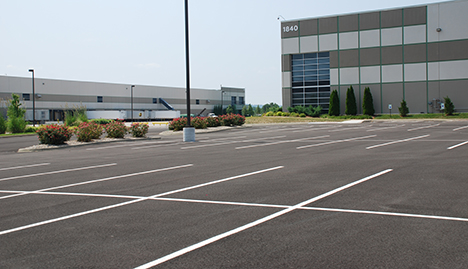
By Dwight Walker, P.E.
Why do so many owners choose asphalt for their parking lots? Asphalt is quick to pave with, versatile, long-lasting and easy to maintain. Parking lots can be built in stages and can be strengthened if demand increases. The parking lot at a building can make a powerful and lasting impression on visitors or customers.
Here are some of the key points for successful parking lots. These points can be grouped as follows:
• structure and drainage
• materials and mix design
• construction and
• maintenance.
Structure and drainage
Well-performing pavements of all types begin with a strong foundation. All vegetation and debris should be removed from the site. Any soft or yielding areas of the subgrade should be removed or drained during grading and compaction. Compaction of the subgrade is important. Where practical, Proctor density testing (or similar tests) should be done to assure that a high degree of compaction is consistently achieved. A well-prepared, unyielding subgrade provides a platform for proper compaction of the HMA and overall pavement support.
Drainage
Drainage problems are one of the most common causes of parking lot pavement failures. If matching the alignment with other features (curbs, gutters, sidewalks, etc.) allows, the parking area should have at least 2 percent (1/4-inch per foot) slope. “Bird baths” or localized depressions that can hold water should be avoided. Interceptor drains can be installed to carry collected run-off away from the pavement. The pavement should be designed and built such that water does not stand at the pavement edge.
Structure
Careful design of a parking lot’s pavement structure is important. Pavement owners can minimize future pavement repair expenses and increase the pavement life by utilizing an appropriate pavement design. Some of the significant factors affecting the required pavement structure include the traffic (both the weight and number of vehicles), the subgrade strength, the properties of the asphalt mixtures and the environment in which the pavement functions.
For large projects, the thickness design analysis should be done by a qualified designer. For lesser installations, there are numerous simplified design procedures. Pavement areas that are used to access loading docks, dumpster sites and similar, predictably heavily loaded locations need additional structure or pavement thickness. Fatigue and/or base failures are common where this practice is not applied. Under-designed pavements can cause costly maintenance problems and greatly reduced service life.
Materials and mix design
The Superpave system is the most commonly used mix design procedure in the U.S. Generally, the finer graded mixes are recommended for parking lots. These mixes typically provide a denser appearing surface, which many owners prefer and are easier to handwork and compact. A design air voids content of 3 to 4 percent (rather than 4 to 5 percent) is recommended for general use parking lots.
In high stress locations (loading docks, dumpster pads, etc.), mixes with a larger top-size aggregate and a coarser grading, along with a stiffer asphalt binder, may be appropriate.
Construction
During the construction of a parking lot, attention to detail is critical.
Subgrade
Make sure the subgrade is well compacted, including areas around manholes, drainage inlets, etc., which may not be readily accessible by full size compactors. Proctor density tests or similar procedures should be done to assure that approximately 95 percent of solid density is consistently achieved. A well-prepared, unyielding subgrade is needed for proper compaction of the HMA and for overall pavement support.
Equipment
Equipment decisions play a significant role in building a good parking lot. The equipment includes haul trucks, an asphalt distributor, the paver and rollers. Matching the equipment size and numbers to the size of the project is important. Highway-class pavers and rollers may not be efficient or maneuverable on smaller jobs.
Rolling
To facilitate compaction of the mix, rolling should start as soon as the mix withstands displacement. During breakdown rolling of the mix, keep the roller as close to the paver as possible to aid in compaction. Rolling should continue until the mat is adequately compacted, about 94 percent of maximum density, and any roller marks are eliminated.
General
Limit the amount of hand working of the mix. Pay attention to the construction and compaction of longitudinal joints; poor joints can lead to an early pavement failure. Avoid unsupported edges. Traffic will exert horizontal stresses at the pavement edge and cracks can develop. This can be avoided by compacting soil or aggregate against the asphalt edge.
Porous parking lots
This specially designed approach to parking lots provides a means of managing storm water runoff by allowing the water to infiltrate the installation and permeate into the soil. This type of pavement has permeable, high-voids asphalt mix over a granular working platform on a reservoir of large, drainable aggregate. These installations require careful design, construction and maintenance, but can provide a means of rainfall runoff management without a retention basin.
Maintenance
Well-designed and constructed parking lots can offer many years of service, but some maintenance may be needed. Two of the maintenance concerns include keeping the drainage features operating and addressing any cracks which form. Drainage work consists of activities such as keeping ditches and outlets free flowing.
Many pavements will experience some cracks during their life. These cracks allow moisture, damaging chemicals such as gasoline or motor oil and other foreign material to enter the pavement and cause deterioration. Sealing can help address this problem by renewing the surface and waterproofing the pavement. Additionally, sealing provides a uniform, pleasing appearance. Crack filling may be needed before general sealing, if the cracking is significant (more than 1/4-inch crack width).
Conclusion
This article is intended to provide general guidance on well-performing asphalt parking lots. More detailed information, including local design practices and materials designations, is needed for specific installations. State asphalt pavement associations have prepared guidance documents which are good sources of this information. Properly designed and constructed asphalt parking lots can be a long-lasting, attractive addition to your site.